目录
4.3 ApplicationContext (新版本的工厂类)
一.了解Spring

- Spring:SE/EE开发的一站式框架(有EE开发的每一层解决方案)
- WEB层 :SpringMVC
- Service层 :Spring的Bean管理,Spring声明式事务
- DAO层 :Spring的Jdbc模板,Spring的ORM模块
功能:

二.Spring入门
2.1 Spring开发包

- docs :Spring的开发规范和API
- libs :Spring的开发的jar和源码
- schema :Spring的配置文件的约束
2.2 创建项目引入jar包
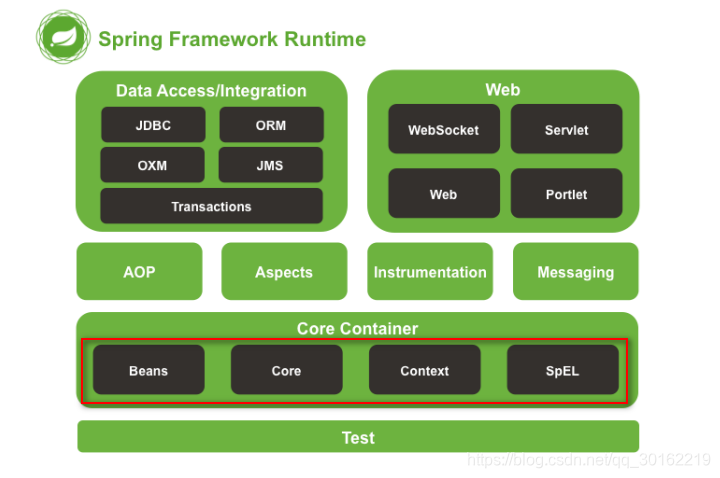
在 Sping开发包中找到以下jar包并引入项目
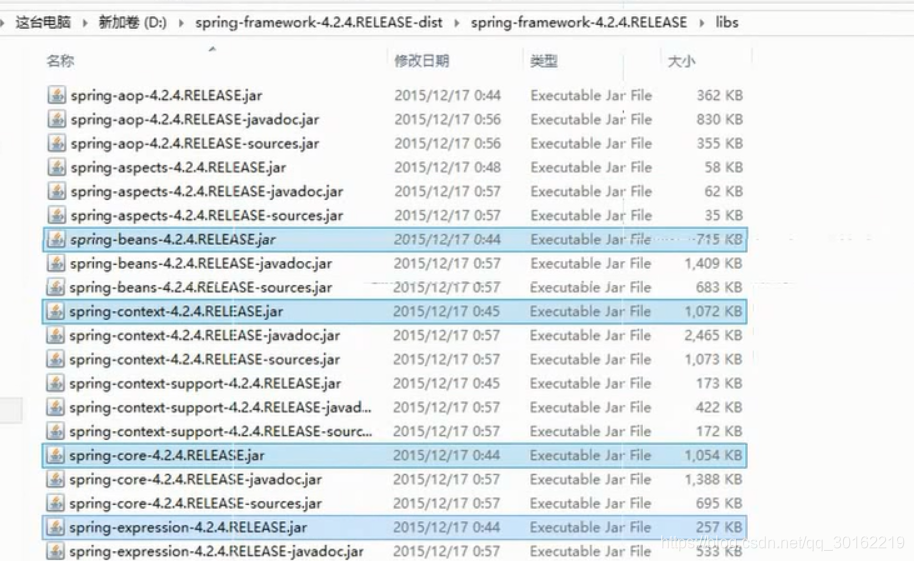


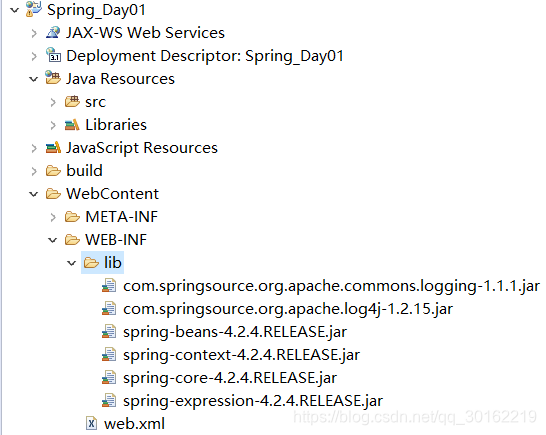
三.IOC&DI
3.1 IOC
IOC: Inversion of Control(控制反转)。
控制反转:将对象的创建权反转给(交给)Spring。
3.1.1 IOC的主题引入
以往我们在项目中处理dao层通常用下面这种方式
/**
* 用户管理DAO层接口
*
*/
public interface UserDAO {
public void save();
}/**
* 用户管理DAO层实现类
*
*/
public class UserDAOImpl implements UserDAO {
@Override
public void save() {
System.out.println("UserDAOImpl执行了...");
}
} /**
* 传统方式的调用
*/
public void demo1(){
UserDAOImpl userDAO = new UserDAOImpl();
userDAO.save();
}问题:
如果底层的实现切换了,需要修改源代码,比如说原本对数据库的操作用的是JDBC,现在要切换成Hibernate,是否可以不修改程序源代码对程序进行扩展?
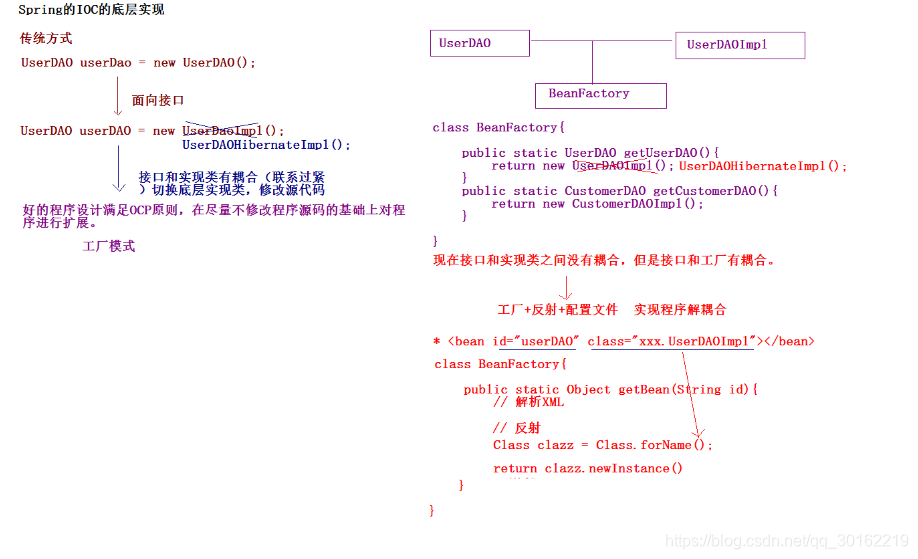
3.1.2 IOC解决上述问题
① 配置XML文件,将实现类交给Spring管理
在项目的src目录下增加配置文件名为 applicationContext.xml
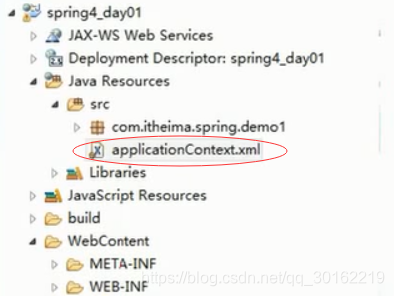
在spring的解压路径下spring-framework-4.2.4.RELEASE\docs\spring-framework-reference\html\xsd-configuration.html 中最下方复制约束放入该配置文件,并在该文件中配置实现类。
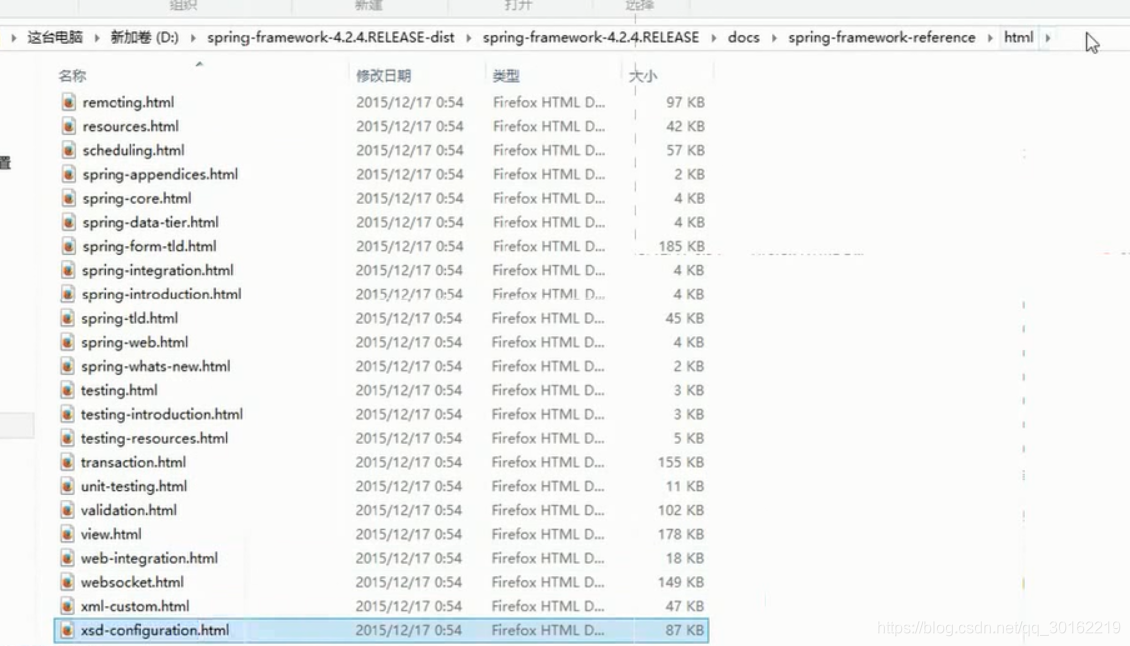
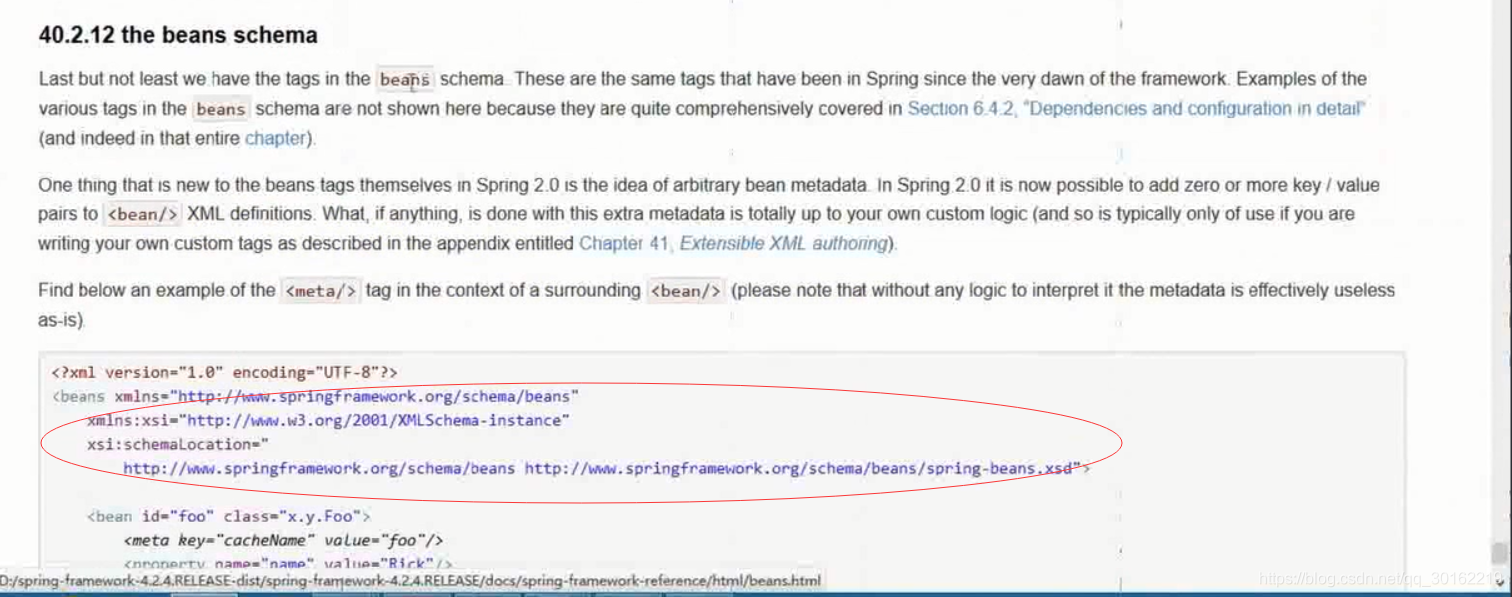
<?xml version="1.0" encoding="UTF-8"?>
<beans
xmlns="http://www.springframework.org/schema/beans"
xmlns:xsi="http://www.w3.org/2001/XMLSchema-instance"
xsi:schemaLocation="
http://www.springframework.org/schema/beans
http://www.springframework.org/schema/beans/spring-beans.xsd">
<!-- Spring的入门的配置==================== -->
<bean id="userDAO" class="com.spring.demo1.UserDAOImpl" >
</bean>
</beans>② 编写测试方法
@Test
public void test02(){
// 创建Spring的工厂
ApplicationContext applicationContext = new ClassPathXmlApplicationContext("applicationContext.xml");
UserDao userDao = (UserDao) applicationContext.getBean("userDao");
userDao.save();
}3.2 DI
依赖注入,前提必须有IOC的环境,Spring管理这个类的时候将类的依赖的属性注入(设置)进来,即在Spring实例化该类时,其中的属性也自动赋值,修改上述 UserDaoImpl实现类增加 name 属性,并设置 set 方法。
/**
* 用户管理DAO层实现类
*
*/
public class UserDAOImpl implements UserDAO {
private String name;
public void setName(String name) {
this.name = name;
}
@Override
public void save() {
System.out.println("UserDAOImpl执行了..."+name);
}
}修改配置文件加入属性
<bean id="userDAO" class="com.itheima.spring.demo1.UserDAOImpl" >
<property name="name" value="李东"/>
</bean>重新运行上述测试类,运行结果为:

四.Spring工厂类
4.1 工厂类结构图
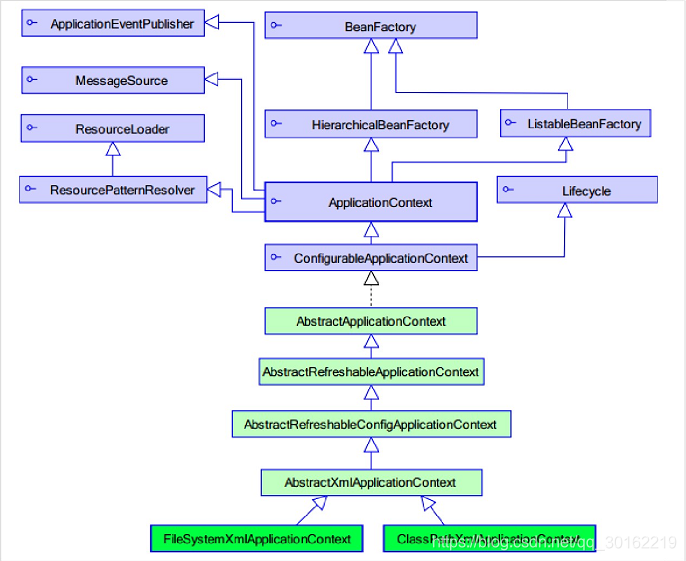
4.2 BeanFactory (老版本的工厂类)
特征:调用getBean的时候,才会生成类的实例
4.3 ApplicationContext (新版本的工厂类)
特征:加载配置文件的时候,就会将Spring管理的类都实例化。
ApplicationContext 有两个实现类
ClassPathXmlApplicationContext:加载类路径下的配置文件
FileSystemXmlApplicationContext:加载文件系统下的配置文件
/**
* 加载磁盘上的配置文件
*/
public void demo3(){
ApplicationContext applicationContext = new FileSystemXmlApplicationContext("C:\\applicationContext.xml");
UserDAO userDAO = (UserDAO) applicationContext.getBean("userDAO");
userDAO.save();
}五.Spring的配置
5.1 Schema本地的配置

① 设置 Key 将下面这句话填入key中
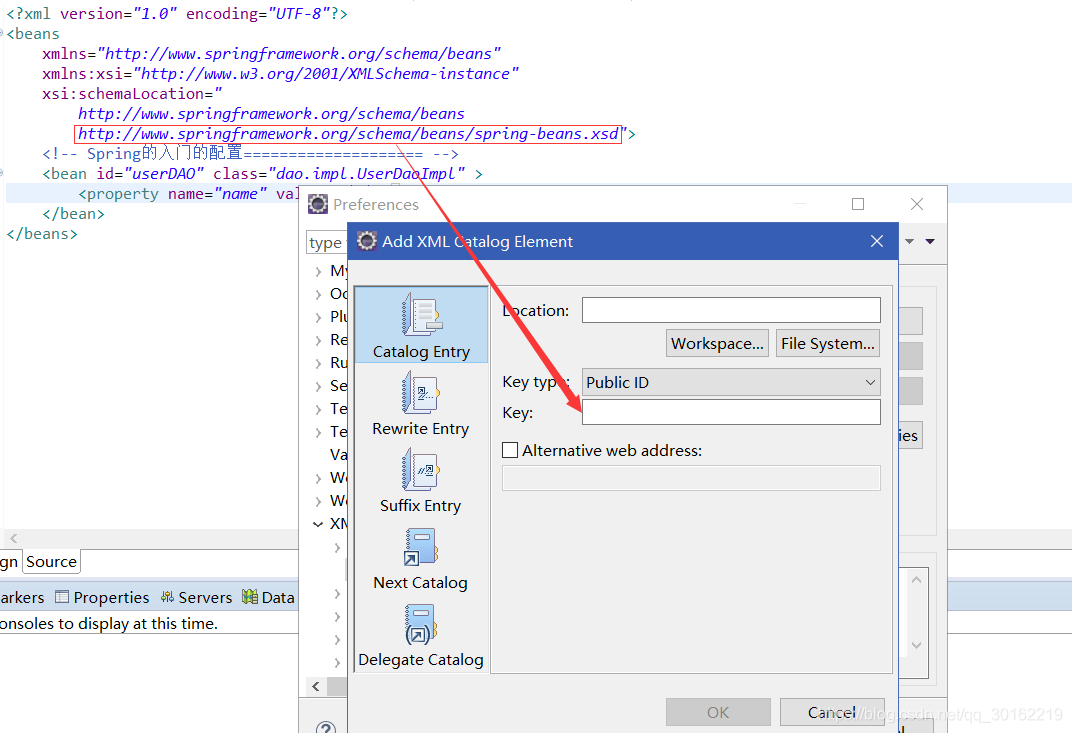
② 设置 Location解压:spring-framework-4.2.4.RELEASE-schema.zip 在beans 目录下 选择 spring-beans-4.2.xsd

③ 设置 KeyType

5.2 Bean的相关配置
5.2.1 <bean>标签的id和name的配置
- id :使用了约束中的唯一约束。里面不能出现特殊字符的。
- name :没有使用约束中的唯一约束(理论上可以出现重复的,但是实际开发不能出现的),里面可以出现特殊字符,其余 功能与id相同。应用在Spring和Struts1框架整合的时候 <bean name=”/user” class=””/>
5.2.2 Bean的生命周期的配置
- init-method :Bean被初始化的时候执行的方法
- destroy-method :Bean被销毁的时候执行的方法(Bean是单例创建,工厂关闭)
案例:
① 新建接口 CustomerDao 和 CustomerDaoImpl
public interface CustomerDao {
public void save();
}public class CustomerDaoImpl implements CustomerDao {
public void setup(){
System.out.println("CustomerDAOImpl被初始化了...");
}
@Override
public void save() {
System.out.println("CustomerDAOImpl的save方法执行了...");
}
public void destroy(){
System.out.println("CustomerDAOImpl被销毁了...");
}
}② 在applicationContext.xml中增加如下配置
<!-- Spring的sBean的生命周期的配置=========== -->
<bean id="customerDao" class="dao.impl.CustomerDaoImpl" init-method="setup" destroy-method="destroy"/>③ 编写测试方法
/**
* 生命周期的配置
*/
public void test03(){
ClassPathXmlApplicationContext applicationContext= new ClassPathXmlApplicationContext("applicationContext.xml");
CustomerDao customerDAO = (CustomerDao) applicationContext.getBean("customerDao");
customerDAO.save();
applicationContext.close();
}运行结果:

5.2.3 Bean的作用范围的配置(重点)
- scope :Bean的作用范围
- singleton :默认的,Spring会采用单例模式创建这个对象。
- prototype :多例模式。(Struts2和Spring整合一定会用到)
- request :应用在web项目中,Spring创建这个类以后,将这个类存入到request范围中。
- session :应用在web项目中,Spring创建这个类以后,将这个类存入到session范围中。
- globalsession :应用在web项目中,必须在porlet环境下使用。但是如果没有这种环境,相对于session。
XML配置案例:
<!-- Spring的sBean的生命周期的配置=========== -->
<bean id="customerDao" class="dao.impl.CustomerDaoImpl" init-method="setup" destroy-method="destroy" scope="prototype" />六.SpringIOC中bean的管理(XML)
6.1 Spring中Bean的实例化方式
Bean已经都交给Spring管理,Spring创建这些类的时候,有几种方式:
6.1.1 无参构造方法的方式(默认)
/**
* 无参数构造方法方式
*
*/
public class Bean1 {
public Bean1() {
super();
System.out.println("Bean1的无参数的构造方法执行了...");
}
} <!-- 无参数构造方法 -->
<bean id="bean1" class="test.Bean1"></bean>public void test05(){
ClassPathXmlApplicationContext applicationContext= new ClassPathXmlApplicationContext("applicationContext.xml");
Bean1 b1 = (Bean1) applicationContext.getBean("bean1");
}运行结果:

6.1.2 静态工厂实例化的方式
① 编写Bean2的静态工厂
/**
* Bean2的静态工厂
*
*/
public class Bean2Factory {
public static Bean2 createBean2(){
System.out.println("Bean2Factory中方法执行了...");
return new Bean2();
}
}② 配置xml文件
<!-- 静态工厂实例化 -->
<bean id="bean2" class="test.Bean2Factory" factory-method="createBean2"/>③编写测试方法
/**
* 静态工厂实例化
*/
public void demo2(){
ApplicationContext applicationContext = new ClassPathXmlApplicationContext("applicationContext.xml");
Bean2 bean2 = (Bean2) applicationContext.getBean("bean2");
System.out.println(bean2);
}6.1.3 实例工厂实例化的方式
① 编写Bean3的实例工厂
/**
* Bean3的实例工厂
*
*/
public class Bean3Factory {
public Bean3 createBean3(){
System.out.println("Bean3的实例工厂执行了...");
return new Bean3();
}
}② 配置xml文件
<!-- 实例工厂实例化 -->
<bean id="bean3Factory" class="test.Bean3Factory"></bean>
<bean id="bean3" factory-bean="bean3Factory" factory-method="createBean3"></bean> ③编写测试方法
/**
* 实例工厂实例化
*/
public void demo3(){
ApplicationContext applicationContext = new ClassPathXmlApplicationContext("applicationContext.xml");
Bean3 bean3 = (Bean3) applicationContext.getBean("bean3");
System.out.println(bean3);
}6.2 Spring的属性注入
6.2.1 构造方法的方式的属性注入
①编写汽车类
public class Car {
private String name;
private Double price;
public Car(String name, Double price) {
super();
this.name = name;
this.price = price;
}
@Override
public String toString() {
return "Car [name=" + name + ", price=" + price + "]";
}
}②配置xml文件
<!-- 构造方法的方式 -->
<bean id="car" class="demo4.Car">
<constructor-arg name="name" value="宝马"/>
<constructor-arg name="price" value="800000"/>
</bean>③测试方法
@Test
/**
* 构造方法方式的属性注入
*/
public void demo1(){
ApplicationContext applicationContext = new ClassPathXmlApplicationContext("applicationContext.xml");
Car car = (Car) applicationContext.getBean("car");
System.out.println(car);
}6.2.2 set方法的方式的属性注入
①实体类
/**
* set方法的属性注入
*
*/
public class Car2 {
private String name;
private Double price;
public void setName(String name) {
this.name = name;
}
public void setPrice(Double price) {
this.price = price;
}
@Override
public String toString() {
return "Car2 [name=" + name + ", price=" + price + "]";
}
}②配置xml文件
<!-- set方法的方式 -->
<bean id="car2" class="demo4.Car2">
<property name="name" value="奔驰"/>
<property name="price" value="1000000"/>
</bean> ③测试方法
/**
* set方法方式的属性注入
*/
public void demo2(){
ApplicationContext applicationContext = new ClassPathXmlApplicationContext("applicationContext.xml");
Car2 car2 = (Car2) applicationContext.getBean("car2");
System.out.println(car2);
}6.2.3 set方法设置对象类型的属性
①实体类
public class Employee {
private String name;
private Car2 car2;
public void setName(String name) {
this.name = name;
}
public void setCar2(Car2 car2) {
this.car2 = car2;
}
@Override
public String toString() {
return "Employee [name=" + name + ", car2=" + car2 + "]";
}
}②配置xml文件
<!-- set方法注入对象类型的属性 -->
<bean id="employee" class="demo4.Employee">
<!-- value:设置普通类型的值,ref:设置其他的类的id或name -->
<property name="name" value="涛哥"/>
<property name="car2" ref="car2"/>
</bean>
<bean id="car2" class="demo4.Car2">
<property name="name" value="奔驰"/>
<property name="price" value="1000000"/>
</bean> ③测试方法
@Test
/**
* set方法注入对象类型
*/
public void demo3(){
ApplicationContext applicationContext = new ClassPathXmlApplicationContext("applicationContext.xml");
Employee employee = (Employee) applicationContext.getBean("employee");
System.out.println(employee);
}6.2.4 P名称空间的属性注入(Spring2.5以后)
在约束中加入下面这句

配置类
<!-- 改为p名称空间的方式 -->
<bean id="car2" class="demo4.Car2" p:name="奇瑞QQ" p:price="30000"></bean>
<bean id="employee" class="demo4.Employee" p:name="王东" p:car2-ref="car2"></bean>6.2.5 SpEL的属性注入(Spring3.0以后)
SpEL:Spring Expression Language,Spring的表达式语言。
语法:#{SpEL}
编写实体类 CarInfo
public class CarInfo {
private String name;
public String getName() {
return "摩托车";
}
public Double calculatorPrice(){
return Math.random() * 3000;
}
}修改xml文件
<!-- SpEL的属性注入 -->
<bean id="carInfo" class="demo4.CarInfo">
</bean>
<bean id="car2" class="demo4.Car2">
<property name="name" value="#{carInfo.name}"></property>
<property name="price" value="#{carInfo.calculatorPrice()}"></property>
</bean>
<bean id="employee" class="demo4.Employee">
<property name="name" value="#{'赵洪'}"></property>
<property name="car2" value="#{car2}"></property>
</bean>6.2.6 集合类型属性注入
①实体类
/**
* 集合属性的注入:
*
*/
public class CollectionBean {
private String[] arrs;
private List<String> list;
private Set<String> set;
private Map<String,String> map;
public void setArrs(String[] arrs) {
this.arrs = arrs;
}
public void setList(List<String> list) {
this.list = list;
}
public void setSet(Set<String> set) {
this.set = set;
}
public void setMap(Map<String, String> map) {
this.map = map;
}
@Override
public String toString() {
return "CollectionBean [arrs=" + Arrays.toString(arrs) + ", list=" + list + ", set=" + set + ", map=" + map
+ "]";
}
}②配置xml文件
<!-- Spring的集合属性的注入============================ -->
<!-- 注入数组类型 -->
<bean id="collectionBean" class="demo4.CollectionBean">
<!-- 数组类型 -->
<property name="arrs">
<list>
<value>王东</value>
<value>赵洪</value>
<value>李冠希</value>
</list>
</property>
<!-- 注入list集合 -->
<property name="list">
<list>
<value>李兵</value>
<value>赵如何</value>
<value>邓凤</value>
</list>
</property>
<!-- 注入set集合 -->
<property name="set">
<set>
<value>aaa</value>
<value>bbb</value>
<value>ccc</value>
</set>
</property>
<!-- 注入Map集合 -->
<property name="map">
<map>
<entry key="aaa" value="111"/>
<entry key="bbb" value="222"/>
<entry key="ccc" value="333"/>
</map>
</property>
</bean>
③测试类
@Test
public void demo1() {
ApplicationContext applicationContext = new ClassPathXmlApplicationContext("applicationContext.xml");
CollectionBean collectionBean = (CollectionBean) applicationContext.getBean("collectionBean");
System.out.println(collectionBean);
}七.SpringIOC的注解开发
7.1 注解开发入门
① 创建web项目,引入jar包
在Spring4中除了引入基本的开发包,还要引入aop包(Spring3中不需要)


② 引入配置文件
在src目录下新建 applicationContext.xml,进行注解开发则需要在其中引入context约束(之前引入的是beans约束)
该约束路径:spring-framework-4.2.4.RELEASE-dist\spring-framework-4.2.4.RELEASE\docs\spring-framework-reference\html\xsd-configuration.html

<?xml version="1.0" encoding="UTF-8"?>
<beans xmlns="http://www.springframework.org/schema/beans"
xmlns:xsi="http://www.w3.org/2001/XMLSchema-instance"
xmlns:context="http://www.springframework.org/schema/context" xsi:schemaLocation="
http://www.springframework.org/schema/beans http://www.springframework.org/schema/beans/spring-beans.xsd
http://www.springframework.org/schema/context http://www.springframework.org/schema/context/spring-context.xsd">
</beans>③ 创建接口和实现类
public interface UserDao {
public void save();
}public class UserDaoImpl implements UserDao {
@Override
public void save() {
System.out.println("dao中保存用户的方法执行了。。。");
}
}④ 开启注解扫描并添加注解
<!-- 指定扫描dao包下的所有类中的注解.注意:扫描包时.会扫描指定包下的所有子孙包 -->
<context:component-scan base-package="dao"></context:component-scan>@Component("userDao") //相当于 xml管理方式的 <bean id="userDao" class="dao.impl.UserDaoImpl"></bean>
public class UserDaoImpl implements UserDao {
@Override
public void save() {
System.out.println("dao中保存用户的方法执行了。。。");
}
}⑤ 测试方法
public void test02(){
ApplicationContext applicationContext = new ClassPathXmlApplicationContext("applicationContext.xml");
UserDao userDao = (UserDao) applicationContext.getBean("userDao");
userDao.save();
}7.2 Spring注解详解
7.2.1 Component 组件
- 修饰一个类,将这个类交给Spring管理,这个注解有三个衍生注解:
- Controller:web层
- Service:service层
- Repository:dao层
- 这三个注解可以代替Component
7.2.2 属性注入的注解
@Value:设置普通属性的值
- 如果属性有set方法,则将注解添加在set方法上方
@Component("userDao")
public class UserDaoImpl implements UserDao {
private String name;
@Value("王东") //默认初始值 王东
public void setName(String name){
this.name = name;
}
@Override
public void save() {
System.out.println("dao中保存用户的方法执行了。。。"+name);
}
}- 没有set方法的话注解加在属性上方
@Component("userDao")
public class UserDaoImpl implements UserDao {
@Value("王东") //默认初始值 王东
private String name;
/* public void setName(String name){
this.name = name;
}*/
@Override
public void save() {
System.out.println("dao中保存用户的方法执行了。。。"+name);
}
}@Autowired:设置对象类型的值,默认是按类型完成属性注入。
实际开发需要按名称完成属性注入,在属性上方使用@Autowired和@Qualifier。
- 按类型注入案例:
编写serivce接口及其实现类
public interface UserService {
public void save();
}@Service("userService")
public class UserServiceImpl implements UserService {
@Autowired
private UserDao userDao;
@Override
public void save() {
System.out.println("userService方法执行了。。。");
userDao.save();
}
}此时为userDao属性赋值时将无视 UserDaoImpl 上方注解名称中的值,因为是按类型注值
- 按名称注入案例:@Qualifier和@Repository中的值要一致
@Service("userService")
public class UserServiceImpl implements UserService {
@Autowired
@Qualifier("userDao")
private UserDao userDao;
@Override
public void save() {
System.out.println("userService方法执行了。。。");
userDao.save();
}
}@Repository("userDao")
public class UserDaoImpl implements UserDao {
@Value("王东") //默认初始值 王东
private String name;
@Override
public void save() {
System.out.println("dao中保存用户的方法执行了。。。"+name);
}
}@Resource:实现对象属性的按名称注入功能,用来代替@Autowired和@Qualifier,注意该注解中的name值
@Service("userService")
public class UserServiceImpl implements UserService {
@Resource(name = "userDao")
private UserDao userDao;
@Override
public void save() {
System.out.println("userService方法执行了。。。");
userDao.save();
}
}7.2.3 其它注解
- 生命周期相关注解
@PostConstruct 初始化注解
@PreDestroy 销毁方法
@Service("customerService")
public class CustomerServiceImpl implements CustomerService {
@PostConstruct //相当于 <bean id="" class="" init-method="setup" destroy-method="destroy"/>
public void init(){
System.out.println("customerService被初始化了!");
}
@Override
public void save() {
System.out.println("customerService的save方法保存了!");
}
@PreDestroy //相当于 <bean id="" class="" init-method="setup" destroy-method="destroy"/>
public void destory(){
System.out.println("customerService被销毁了!");
}
}- Bean作用范围的注解
@Scope
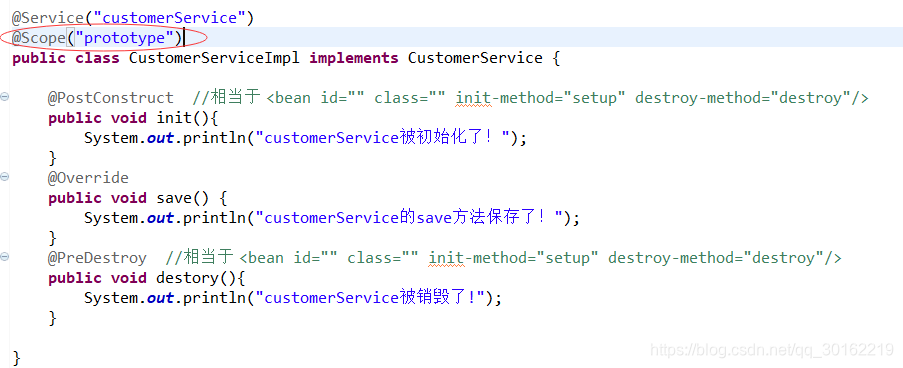
7.3 IOC的XML和注解开发比较
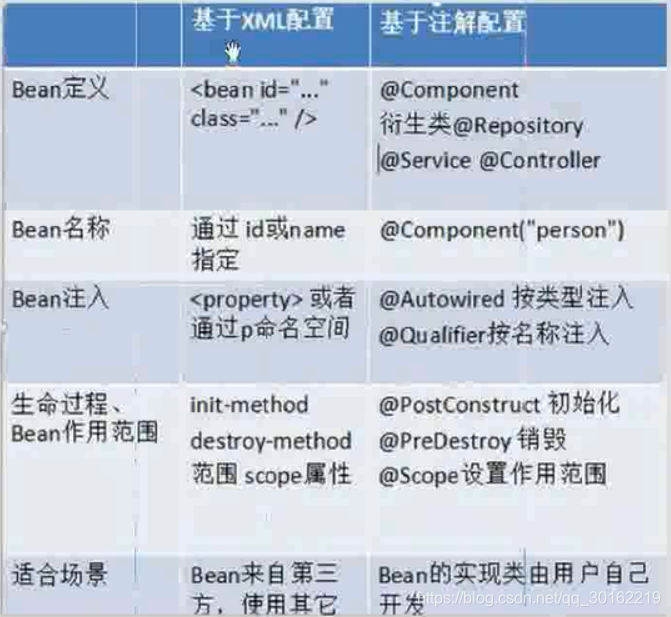

7.4 XML和注解的整合开发
- xml管理bean,注解完成属性注入
①编写接口及实现类
public interface OrderDao {
public void save();
}
public class OrderDaoImpl implements OrderDao {
@Override
public void save() {
System.out.println("OrderDao的save方法执行了。。。");
}
}public interface ProductDao {
public void save();
}
public class ProductDaoImpl implements ProductDao {
@Override
public void save() {
System.out.println("ProductDao的save方法执行了。。。");
}
}public interface ProductService {
public void save();
}
public class ProductServiceImpl implements ProductService {
@Resource(name = "productDao")
private ProductDao productDao;
@Resource(name = "orderDao")
private OrderDao orderDao;
/** 使用@resource可以不用set方法
public void setProductDao(ProductDao productDao) {
this.productDao = productDao;
}
public void setOrderDao(OrderDao orderDao) {
this.orderDao = orderDao;
}
*/
@Override
public void save() {
productDao.save();
orderDao.save();
System.out.println("ProductService的save方法执行了。。。");
}
}②配置xml文件,将类交给spring管理
<?xml version="1.0" encoding="UTF-8"?>
<beans xmlns="http://www.springframework.org/schema/beans"
xmlns:xsi="http://www.w3.org/2001/XMLSchema-instance"
xmlns:context="http://www.springframework.org/schema/context" xsi:schemaLocation="
http://www.springframework.org/schema/beans http://www.springframework.org/schema/beans/spring-beans.xsd
http://www.springframework.org/schema/context http://www.springframework.org/schema/context/spring-context.xsd">
<!-- 指定扫描dao包下的所有类中的注解.注意:扫描包时.会扫描指定包下的所有子孙包 -->
<!-- <context:component-scan base-package="spring"></context:component-scan> -->
<!-- 由于bean是通过xml配置的,所以无需开启类注解扫描,只需开启属性注解扫描 -->
<context:annotation-config></context:annotation-config>
<bean id="productDao" class="spring.dao.impl.ProductDaoImpl"></bean>
<bean id="orderDao" class="spring.dao.impl.OrderDaoImpl"></bean>
<bean id="productService" class="spring.service.impl.ProductServiceImpl"></bean>
</beans>
八.Spring分模块开发与项目优化
8.1 引入配置文件
在applicationContext.xml中引入其他配置文件
<import resource="applicationContext2.xml"/> 8.2 Spring项目优化
8.2.1 问题:
每次请求都会创建一个Spring的工厂,这样浪费服务器资源,应该一个项目只有一个Spring的工厂。
8.2.2 解决方案:
- 在服务器启动的时候,创建一个Spring的工厂,创建完工厂,将这个工厂类保存到ServletContext中,每次使用的时候都从ServletContext中获取,使用ServletContextListener,监听ServletContext对象的创建和销毁。
- 引入jar包:spring-web.jar
- 配置监听器

- 在Action中获取工厂









 本文详细介绍Spring框架的基础知识,包括Spring的结构、IOC与DI概念、工厂类使用、配置管理、Bean生命周期与作用范围,以及Spring中Bean的实例化与属性注入方式。同时,深入探讨Spring的注解开发,对比XML与注解开发,最后讲解Spring的模块化开发与项目优化策略。
本文详细介绍Spring框架的基础知识,包括Spring的结构、IOC与DI概念、工厂类使用、配置管理、Bean生命周期与作用范围,以及Spring中Bean的实例化与属性注入方式。同时,深入探讨Spring的注解开发,对比XML与注解开发,最后讲解Spring的模块化开发与项目优化策略。
















 1190
1190

 被折叠的 条评论
为什么被折叠?
被折叠的 条评论
为什么被折叠?








